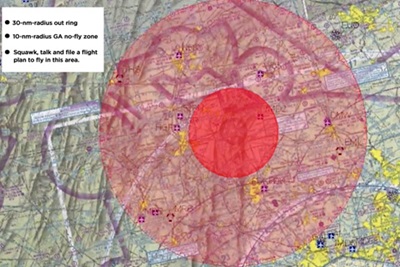 Super Bowl 50 and the president’s State of the Union address have come and gone, but pilots still have a number of significant and sizeable temporary flight restrictions that will affect their flying in 2016.
Super Bowl 50 and the president’s State of the Union address have come and gone, but pilots still have a number of significant and sizeable temporary flight restrictions that will affect their flying in 2016.
Upcoming significant events include the Association of Southeast Asian Nations’ global nuclear summit, to be held Feb. 15 through 16 in Palm Springs, California; the Republican National Convention, July 18 through 21 in Cleveland; and the Democratic National Convention, July 25 through 28 in Philadelphia, said Brian Throop, manager of special operations security for the FAA’s System Operations Security Directorate. Throop addressed attendees at the Flight School Association of North America's annual meeting on Feb. 10.
The national presidential conventions will particularly affect pilots, Throop said. “You’ll see small TFRs during television hours, and as more delegates [arrive], it will grow” to a 10-nautical-mile inner ring and a 30-nm outer ring, he said.
The good news is, there is no incumbent president running for office, “so you won’t see an incumbent campaign around the country,” Throop said. If that were the case, pilots would see numerous 30-nm TFRs around the nation. “We hope to see a smaller number this year,” he said. “The Secret Service has not requested TFRs for candidates so far.” Individual nominees have a historical record of seeking airspace restrictions—typically three miles in size, similar to the dimensions of TFRs for the vice president, he said.
Throop said four airplanes violated the Super Bowl 50 TFR. Three pilots “bounced off the outer ring” and will be referred to their local flight standards district office. The fourth pilot “got a real good look at our Air Force’s finest technology,” Throop said.
Other TFRs that pilots can expect include a VIP visit to Martha’s Vineyard in late August, lasting 10 to 14 days; and a VIP visit to Hawaii in December. There will be approximately 5,000 sporting events with accompanying TFRs in 2016, Throop added.
“We absolutely understand the pain some of these restrictions inflict on you on a daily basis,” Throop told the conference attendees. He said the FAA approves about 2 percent of all TFR requests. The agency gets a lot of requests for things like, “I’m getting married next week and I don’t want helicopters flying over.” (The division's response is “Congratulations, but no.”)
Disaster, presidential and VIP movement, airshow, sporting event, national security event, and law enforcement TFRs most broadly affect pilots, Throop noted. He said the agency is considering a new category of TFR that would combine national security and law enforcement. Its development was prompted by the 2009 murders of four Seattle police officers who were gunned down in a coffee shop and the fact that their funerals became a high-profile event. “I call it the ‘right thing to do’ TFR,” Throop said.
Pilots should review notices to airmen before every flight. AOPA offers several resources, including a graphical map, list, and email alerts to members within a 250-nm distance of an impending TFR. Pilots also can follow alerts on Twitter and Facebook.



